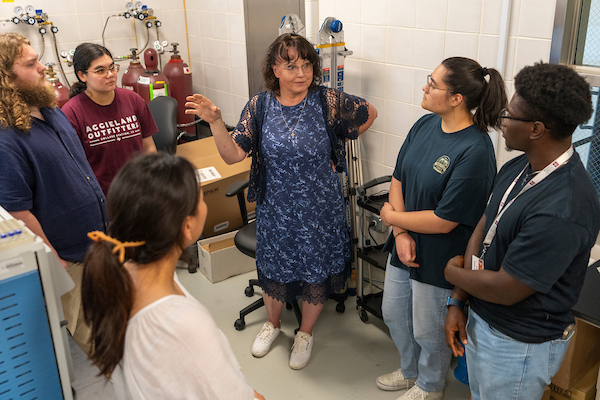Researchers find unexpected link between essential fats and insulin aggregation
Some fatty acids can cause insulin to form toxic clumps in solution
Scientists within Texas A&M AgriLife Research have discovered a surprising connection between certain fatty acids and insulin when mixed in solution. Their study, published in ACS Chemical Neuroscience and funded by the National Institutes of Health, showed the presence of fats led insulin to clump together and form toxic aggregates.

These omega-3 and omega-6 fatty acids are essential dietary components needed for cell growth and membrane structures. They are also believed to provide an array of health benefits including improved memory and cognition as well as lowered inflammation and unhealthy cholesterol levels.
Because of these benefits, foods rich in these fatty acids — like plant-based oils and fatty fish — are often favored dietary choices. Many of these fatty acids can even be taken as supplements. On grocery store shelves, it’s easy to find long-chain fatty acid supplements like docosahexaenoic acid, DHA, and arachidonic acid, ARA, as well as fish oil — a cocktail of different types of fatty acids.
“Most of us think of these fats as good or healthy, and, for many people, they are,” said Dmitry Kurouski, Ph.D., professor in the Texas A&M College of Agriculture and Life Sciences Department of Biochemistry and Biophysics. “However, we found that these polyunsaturated fatty acids can do a very unexpected thing when they interact with insulin. And this is not just true for one or two of these fatty acids, but a large group of them.”
Insulin interaction with fatty acids
Insulin is a protein important to human metabolism, and defects in insulin production or function are associated with diabetes. Previous research has shown that some fatty acids speed up the aggregation of insulin. This is a potential problem because the aggregation, or clumping together, of various proteins in the body is linked to a range of diseases and disorders.
Researchers in Kurouski’s lab, including Zachary Hoover, a graduate student who designed the experiments with Kurouski and served as the study’s first author, wanted to test the interactions between insulin and a greater range of fatty acids. They did so by mixing them together in a solution meant to mimic the bodily conditions of a person with insulin-derived amyloidosis — a rare but potentially serious condition that occurs in people with Type 1 diabetes when repeated insulin injections result in a buildup of insulin in the skin.
Their study analyzed the impact of 10 different fatty acids on insulin aggregation, and they found that all the fatty acids significantly accelerated aggregation. Further, the team observed the effect of insulin aggregates in animal model brain cells. Insulin aggregates formed in the presence of the studied fatty acids were more toxic than insulin aggregates formed in a fat-free solution.
“What happens is the insulin becomes very rigid in the aggregate form,” Kurouski said. The insulin clusters are shaped like rods, he explained, which enter cells and cause a lot of damage because they are so rigid. “It’s like the cells are eating iron nails.”
Navigating nutritional complexity
Despite these results, Kurouski doesn’t recommend cutting these essential fatty acids from anyone’s diet.

“This is fundamental research that requires more investigation,” he said. “What this work shows is that the picture is more complex, nutrition is complex, and we shouldn’t treat anything as black and white, universally healthy or unhealthy.”
Kurouski believes the next steps in this research will involve studying the health impacts within animal models and eventually within human studies. Right now, Kurouski’s lab is working with the animal model C. elegans, a type of microscopic worm.
In the future, mammalian studies could help clarify the dosage of fatty acids within a living organism that might trigger a harmful amount of insulin aggregation — a question that currently remains unknown.
Kurouski, an associate member of the Texas A&M Institute for Advancing Health Through Agriculture, said this type of research might also be investigated by the institute one day as part of its work studying precision nutrition, an individualized approach to wellness.
Diving deeper with neurodegenerative disease
Looking forward, Kurouski’s lab plans to examine the interaction between fatty acids and proteins beyond insulin, especially those whose aggregates have already been implicated in the onset of neurodegenerative diseases like Alzheimer’s and Parkinson’s diseases.
He said that elucidating the molecular interactions between these proteins and fats is a key foundational step to understanding disease onset. This research may one day help with the development of therapeutics capable of breaking up the toxic aggregates — and potentially even reverse the damage of these currently incurable diseases.
In the meantime, Kurouski said individuals may need to strike a balance between ensuring their diet includes essential fatty acids while limiting excess fats. This is where precision nutrition becomes very useful.
“It all comes down to nutrition and a healthy diet for the individual. Very few things can be good for everyone, and we have evidence that these types of fats may not always be beneficial. We should be careful what we think of as broadly good or healthy foods, and always discuss with a doctor or nutritionist to find the eating style and supplements that work for you,” he said.





